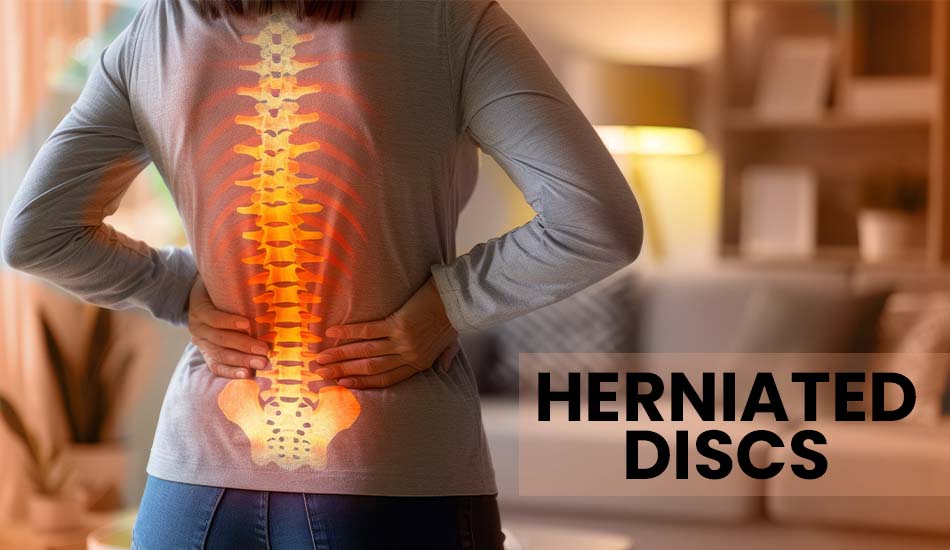
Herniated Discs: Common Causes and Risk Factors
Thursday, 23rd May 2024A herniated disc, often referred to as a slipped or ruptured disc, is a common condition that can cause significant pain and discomfort. Understanding the causes and risk factors associated with herniated discs can help in prevention and early intervention. This article explores the common causes and risk factors of herniated discs, providing valuable insights into this prevalent spinal condition.
What is a Herniated Disc?
A herniated disc occurs when the soft, gel-like center of an intervertebral disc (nucleus pulposus) pushes through a tear in the tougher, outer layer (annulus fibrosus) of the disc. This can irritate or compress nearby nerves, leading to pain, numbness, or weakness in the affected area. Herniated discs most commonly occur in the lower back (lumbar spine) but can also affect the neck (cervical spine).
Common Causes of Herniated Discs
Aging and Degeneration
Aging is one of the primary causes of herniated discs. As we age, the intervertebral discs lose some of their water content, making them less flexible and more prone to tearing or rupturing with even a minor strain or twist. This process is known as disc degeneration.
Injury or Trauma
Injury or trauma to the spine can cause a herniated disc. This might result from a fall, a blow to the back, or sudden pressure on the spine. Such incidents can cause the outer layer of the disc to tear, allowing the inner gel to herniate.
Improper Lifting Techniques
Using improper lifting techniques, such as bending at the waist instead of the knees, can put excessive pressure on the spine and lead to a herniated disc. It's essential to use correct lifting methods to protect your back.
Repetitive Movements
Engaging in repetitive movements, particularly those involving twisting or bending, can increase the risk of disc herniation. Jobs or activities that require repeated heavy lifting, pulling, or pushing can contribute to the condition.
Sudden Strain
A sudden strain on the back, such as lifting a heavy object incorrectly or twisting abruptly, can cause a herniated disc. This is particularly true for individuals who do not regularly engage in physical activity or do not condition their muscles.
Risk Factors for Herniated Discs
Age
Age is a significant risk factor for herniated discs. Most cases occur in individuals between the ages of 30 and 50, when the discs naturally start to degenerate and lose their elasticity.
Genetics
Genetics can play a role in the likelihood of developing herniated discs. If your family has a history of disc problems, you may be more susceptible to experiencing similar issues.
Occupation
Certain occupations that involve physically demanding tasks, such as heavy lifting, repetitive movements, or prolonged sitting, can increase the risk of herniated discs. Jobs that require long periods of driving, which involves continuous vibration and seated posture, also pose a risk.
Sedentary Lifestyle
A sedentary lifestyle can contribute to the development of herniated discs. Lack of regular physical activity can weaken the muscles that support the spine, making the discs more prone to injury.
Obesity
Obesity increases the stress on the spine and discs, raising the risk of herniation. Excess body weight, particularly in the abdominal area, can put additional pressure on the lower back.
Smoking
Smoking is a risk factor for herniated discs as it reduces oxygen supply to the disc tissues, leading to faster degeneration. Smoking can also impede the healing process, making recovery from disc injuries more challenging.
Poor Posture
Maintaining poor posture over time can strain the spine and contribute to disc herniation. Sitting or standing incorrectly, especially for extended periods, can cause misalignment and increase pressure on the discs.
Lack of Exercise
Lack of exercise can lead to weak core muscles, which are crucial for supporting the spine. A strong core helps maintain proper posture and reduces the risk of disc herniation.
Prevention Tips
While some risk factors for herniated discs, such as age and genetics, cannot be controlled, there are steps you can take to reduce your risk:
Maintain a Healthy Weight
Keeping a healthy weight reduces the strain on your spine and lowers the risk of herniated discs. Regular physical activity and a balanced diet can help achieve and maintain a healthy weight.
Exercise Regularly
Regular exercise strengthens the muscles that support your spine, improving flexibility and reducing the risk of injury. Focus on exercises that build core strength, such as yoga, Pilates, and strength training.
Use Proper Lifting Techniques
Always use proper lifting techniques to avoid placing undue stress on your back. Bend your knees, keep your back straight, and lift with your legs, not your back.
Practice Good Posture
Maintaining good posture while sitting, standing, and moving can help protect your spine. Use ergonomic furniture and take regular breaks to stretch and move around if you sit for long periods.
Avoid Smoking
Avoid smoking to improve overall health and reduce the risk of disc degeneration. Quitting smoking can enhance oxygen flow to the spine and aid in the prevention and healing of disc injuries.
Stay Active
Incorporate physical activity into your daily routine to keep your spine healthy. Even simple activities like walking, swimming, or cycling can be beneficial.
Conclusion
Herniated discs can cause significant discomfort and affect daily life, but understanding the common causes and risk factors can help in prevention and early intervention. By adopting a healthy lifestyle, practicing proper lifting techniques, and maintaining good posture, you can reduce your risk of developing herniated discs. If you experience symptoms of a herniated disc, such as back pain, numbness, or weakness, consult with a healthcare professional to explore your treatment options and manage your condition effectively.


